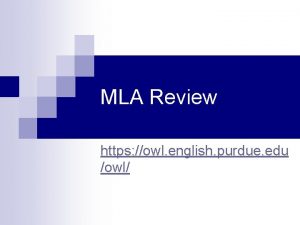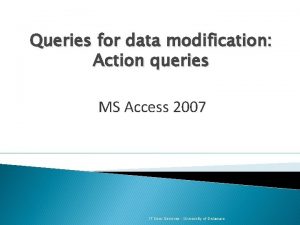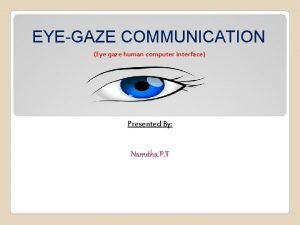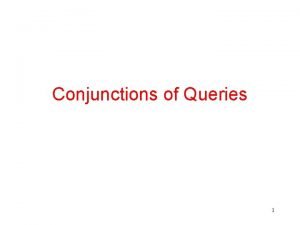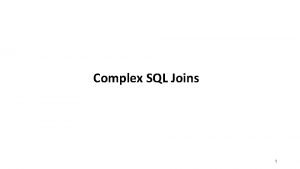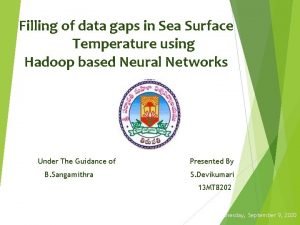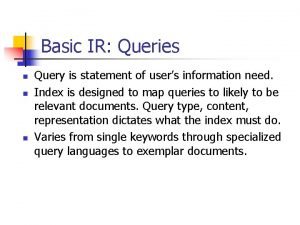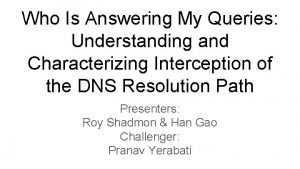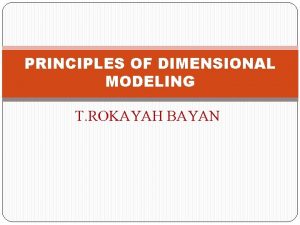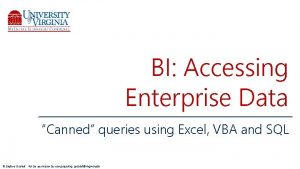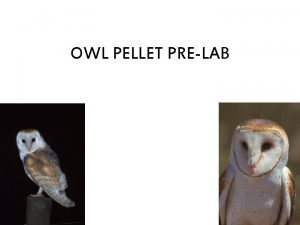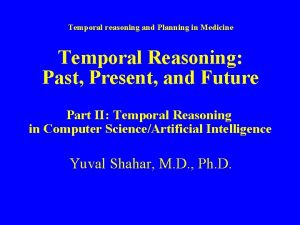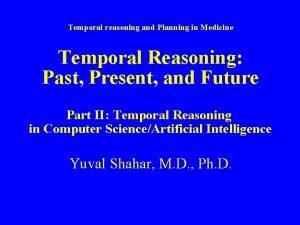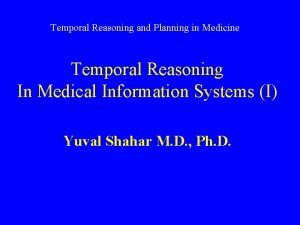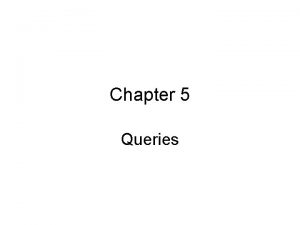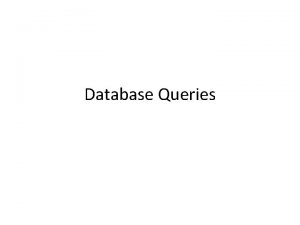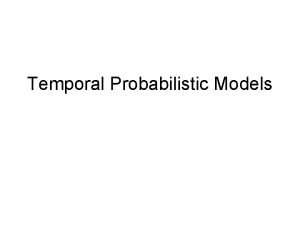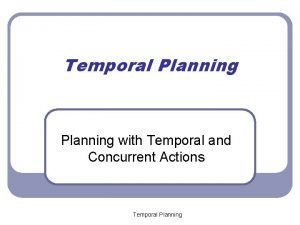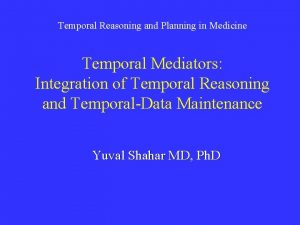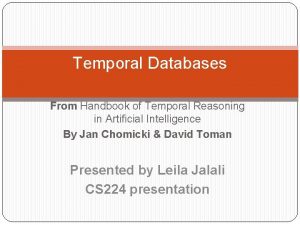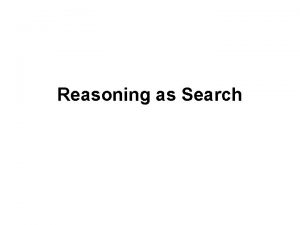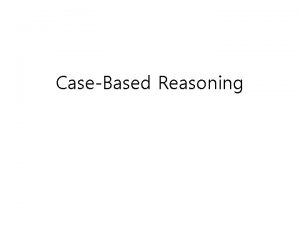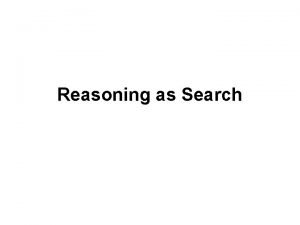Temporal Reasoning for Supporting Temporal Queries in OWL


![4 D Fluents [Welty & Fikes 2006] Classes Time. Slice, Time. Interval are introduced 4 D Fluents [Welty & Fikes 2006] Classes Time. Slice, Time. Interval are introduced](https://slidetodoc.com/presentation_image_h2/96f7bb8b106bc86994c0e6d12f47ffa4/image-3.jpg)

![N-ary approach [Noy & Rector 2006] Dynamic Properties are attached to reified objects representing N-ary approach [Noy & Rector 2006] Dynamic Properties are attached to reified objects representing](https://slidetodoc.com/presentation_image_h2/96f7bb8b106bc86994c0e6d12f47ffa4/image-5.jpg)












![Future Work Extending representation-query language for spatial information [Batsakis & Petrakis, Rule. ML 2011] Future Work Extending representation-query language for spatial information [Batsakis & Petrakis, Rule. ML 2011]](https://slidetodoc.com/presentation_image_h2/96f7bb8b106bc86994c0e6d12f47ffa4/image-18.jpg)

- Slides: 19

Temporal Reasoning for Supporting Temporal Queries in OWL 2. 0 Sotiris Batsakis, Kostas Stravoskoufos Euripides G. M. Petrakis Technical University Of Crete Intelligent Systems Laboratory

Problem Definition Representing evolution of information in time using OWL Temporal relations involve at least three arguments ◦ OWL represents binary relations Existing approaches: Temporal RDF, Named Graphs, Reification, Versioning, N-ary, 4 D-fluents ◦ No qualitative information ◦ Limited OWL reasoning support Querying of temporal information is also a problem We propose a solution to all these problems based on 4 D-fluents and N-ary relations. Techical University Of Crete Intelligent Systems Laboratory 2
![4 D Fluents Welty Fikes 2006 Classes Time Slice Time Interval are introduced 4 D Fluents [Welty & Fikes 2006] Classes Time. Slice, Time. Interval are introduced](https://slidetodoc.com/presentation_image_h2/96f7bb8b106bc86994c0e6d12f47ffa4/image-3.jpg)
4 D Fluents [Welty & Fikes 2006] Classes Time. Slice, Time. Interval are introduced Dynamic objects become instances of Time. Slice Temporal properties of dynamic classes become instances of Time. Interval A time slice object is created each time a (fluent) property changes 3

4 -D fluents example Techical University Of Crete Intelligent Systems Laboratory 4
![Nary approach Noy Rector 2006 Dynamic Properties are attached to reified objects representing N-ary approach [Noy & Rector 2006] Dynamic Properties are attached to reified objects representing](https://slidetodoc.com/presentation_image_h2/96f7bb8b106bc86994c0e6d12f47ffa4/image-5.jpg)
N-ary approach [Noy & Rector 2006] Dynamic Properties are attached to reified objects representing events Dynamic properties are represented as properties and not as objects of properties as in reification Event objects ◦ Attached to specific static objects ◦ Connect to Time Intervals 5

N-ary and Reification example Techical University Of Crete Intelligent Systems Laboratory 6

4 -D fluents/N-ary: Comments Advantages ◦ Changes affect only related dynamic objects, not the entire ontology ◦ Reasoning mechanisms and semantics of OWL fully supported ◦ OWL 2. 0 compatible Disadvantages ◦ Proliferation of objects Techical University Of Crete Intelligent Systems Laboratory 7

Extending 4 -D fluents/N-ary Information: Points, intervals Quantitative and Qualitative information Qualitative Allen Relations (e. g. , Before, After) are supported ◦ Qualitative relations connect temporal intervals ◦ Intervals with unknown endpoints ◦ Interval relations are translated into point relations (Before, After, Equals) Techical University Of Crete Intelligent Systems Laboratory 8

Allen Temporal Relations Techical University Of Crete Intelligent Systems Laboratory 9

Reasoning Infer new relations from existing ones ◦ Before(x, y) AND Before(y, z) Before(x, z) Problem 1: Reasoning over a mix of qualitative and quantitative information is a problem ◦ Extract qualitative relations from quantitative ones ◦ Reasoning over qualitative information Problem 2: Assertions may be inconsistent or new assertions may take exponential time to compute Solution: Restrict to tractable sets decided by polynomial algorithms such as Path Consistency [van Beek & Cohen 1990]

Temporal Reasoning(1/2) Path Consistency suggests composing and intersecting relations until: ◦ A fixed point is reached (no additional inferences can be made) ◦ An empty relation is yielded implying inconsistent assertions Path Consistency is tractable, sound and complete for specific sets of temporal relations Techical University Of Crete Intelligent Systems Laboratory 11

Temporal Reasoning (2/2) Compositions and intersections of relations are defined and implemented in SWRL: Before(x, y) AND Equals(y, z) Before(x, z) (Before(x, y) OR Equals(x, y)) AND (After(x, y) OR Equals(x, y)) Equals(x, y) Techical University Of Crete Intelligent Systems Laboratory 12

SOWL Query Language SPARQL-like query language supporting temporal operators SELECT ? x, ? y… Where { ? x property ? y… At(date)…} Additional operators are introduced to SPARQL ◦ AT, ALWAYS_AT, SOMETIMES_AT ◦ Allen operators

Temporal Operators AT specifies time instants for which fluent properties hold true ALWAYS_AT, SOMETIMES_AT: Return intervals that fluent always or sometime holds. Allen’s operators: BEFORE, AFTER, MEETS, METBY, OVERLAPS, OVERLAPPEDBY, DURING, CONTAINS, STARTEDBY, ENDS, ENDEDBY and EQUALS Techical University Of Crete Intelligent Systems Laboratory 14

AT Temporal Operator Example SELECT ? x, ? y WHERE {? x has-employee ? y AT “ 3 -5 -2007” } Techical University Of Crete Intelligent Systems Laboratory 15

Allen Operator Example SELECT ? x, ? y WHERE {? x has-employee ? y BEFORE company 1 has-employee ? y } Techical University Of Crete Intelligent Systems Laboratory 16

Conclusion We extended 4 D-fluents and N-ary relations for representing evolution of qualitative (in adition to quantitative) temporal information in OWL ontologies Offers temporal reasoning support over qualitative and quantitative relations Querying support by extending SPARQL with additional temporal operators Techical University Of Crete Intelligent Systems Laboratory 17
![Future Work Extending representationquery language for spatial information Batsakis Petrakis Rule ML 2011 Future Work Extending representation-query language for spatial information [Batsakis & Petrakis, Rule. ML 2011]](https://slidetodoc.com/presentation_image_h2/96f7bb8b106bc86994c0e6d12f47ffa4/image-18.jpg)
Future Work Extending representation-query language for spatial information [Batsakis & Petrakis, Rule. ML 2011] Optimizations for large scale applications Techical University Of Crete Intelligent Systems Laboratory 18

Thank you Questions ?
 Mla purdue owl
Mla purdue owl Deductive method
Deductive method Deductive reasoning examples
Deductive reasoning examples Inductive vs deductive geometry
Inductive vs deductive geometry Inductive reasoning moves from
Inductive reasoning moves from Every quiz has been easy therefore the quiz will be easy
Every quiz has been easy therefore the quiz will be easy Dedictive reasoning
Dedictive reasoning Patterns and inductive reasoning
Patterns and inductive reasoning Action queries in access
Action queries in access Any queries
Any queries Suggestions and queries
Suggestions and queries Conjunctive queries
Conjunctive queries Complex sql join queries
Complex sql join queries Any queries
Any queries Ir queries
Ir queries For any queries
For any queries Answering my queries
Answering my queries Dimensional modeling basics
Dimensional modeling basics Rrc permit query
Rrc permit query Stefano grazioli
Stefano grazioli
